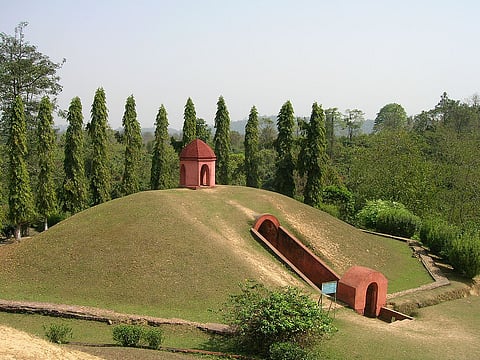
- Destinations
- Experiences
- Stay
- What's new
- Editor’s Picks
- Responsible Tourism
- CampaignsCampaigns
- Subscribe

Located in the northeastern region of India, Assam is known for its rich cultural heritage, stunning landscapes, and vibrant traditions. Amidst this diversity, you'll find a remarkable historical gem – the Ahom Maidams, the royal burial grounds of the Ahom dynasty. These ancient structures encapsulate Assam's majestic history, offering a captivating blend of history, architecture, and folklore. Now they are in the news as Charaideo Maidam has been nominated to become North East India’s first UNESCO World Heritage Site in the cultural category. The nomination was announced by Prime Minister Narendra Modi at the 46th session of the World Heritage Committee in New Delhi held from July 21-31. If accepted, Charaideo Maidam will be India's 43rd World Heritage Site, joining Kaziranga National Park and Manas National Park, which are listed under the natural category.
The royal burials at Charaideo, consisting of 90 sites, will be the first cultural heritage site in the entire northeast region of India to receive such esteemed recognition. A recent report by ICOMOS (the International Council on Monuments and Sites) highlighted the significance of the Maidams, noting their representation of the 600-year-old traditions of the Tai-Ahom people at Charaideo.
The site covers an area of 95.02 hectares with a buffer zone of 754.511 hectares, showcasing the cultural heritage and funerary customs of the Tai-Ahom dynasty. Recognised by ICOMOS as an exceptional representation of the Tai-Ahom necropolis, the nominated property embodies their distinct funerary traditions and cosmologies. The Charaideo necropolis is located on elevated land and is home to the highest concentration and best-preserved examples of these burial mounds in the Brahmaputra Valley. Within these burial vaults, the remains of kings and other royals are interred, along with items such as food, horses, elephants, and sometimes even queens and servants.
In their 2024 assessments, ICOMOS evaluated 36 nominations, including 19 new nominations from around the world. Out of these, six new nominations originated from Asia and the Pacific, with 'Maidams – the Mound-Burial System of the Ahom Dynasty' being the sole nomination from India this year.
Reports say that there are actually over 150 maidams, but only 30 are protected by the Archaeological Survey of India (ASI) and the Assam State Archaeology Department. The roots of the name come from the Tai Ahom term "Che Rai Doi" or "Doi Che Rai," which means "the dazzling city on the hills."
Maidams are impressive two-story vaulted chambers with a passageway and arch leading to the entrance. The mound, constructed of mud with a polygonal toe-wall and a reinforced base, is then layered with bricks and soil. Over time, it becomes covered with a layer of plants, resembling hillocks.
Similar to pyramids, maidams feature a domed chamber with a raised platform in the middle where the body is laid to rest. Along with the body, numerous artifacts belonging to the royalty, such as royal insignia, wooden, ivory, or iron artifacts, gold pendants, pottery, weapons, and clothing are also buried. You can read more about them here.
